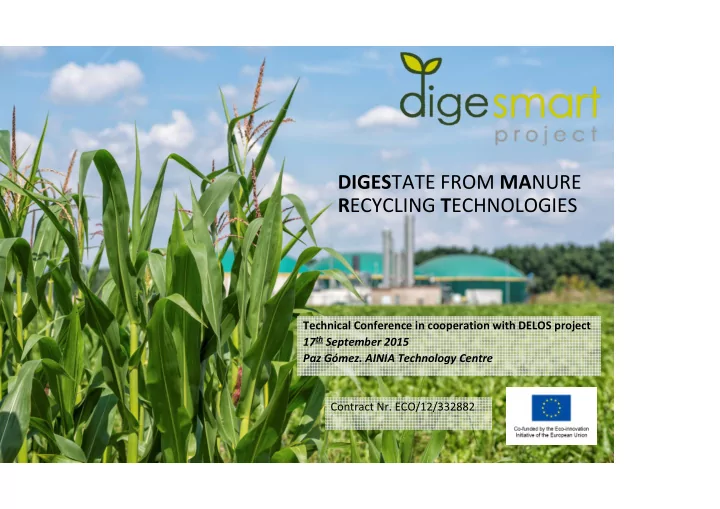

DIGES TATE FROM MA NURE R ECYCLING T ECHNOLOGIES Technical Conference in cooperation with DELOS project 17 th September 2015 Paz Gómez. AINIA Technology Centre Contract Nr. ECO/12/332882
Eco-innovation DIGESTATE FROM MANURE RECYCLING TECHNOLOGIES Contract Nr. ECO/12/332882 • Validation and replication of ammoniumstripping/scrubbing. • Investigating solar drying complementation • Testing and validation of green fertilisers
Objectives
Partners • DETRICON (Belgium). SME developing the stripping plant • BIOGAS ‐ E (Belgium) • AINIA (Spain) • UNITO (Italy) • SATA (Italy)
DETRICON is proposing a solution to produce green fertilizers with stripping technology and an optional module of solar drying Digestate obtained at the end of the AD process is. a) Centrifuged b) Liquid fraction will be treated through a high temperature stripping (thermal energy from the CHP) c) Optionally, the residue from the stripping could be further dried using solar energy
The project is especially focusing on the ammonium fertilizer: ammonium nitrate (18m%N )
First trials - stripping First testing on thin fraction of digestate with following characteristics: ‐ 9% DM ‐ 6,7 kg N ‐ NH4/ton ‐ High viscosity (reason is a bad mechanical separation (screw press) without polymers) Adding: 20 kg CaO/ton
First results - stripping Conclusions: 1. Bad separation gives higher CaO need. Possible impact on the carbonates buffer. 2. High viscosity gives a bad sedimentaion of CaPO4 flocs (only 0,6 kg free phosphates precipitated) 3. Further stripping can still lower the N ‐ NH4 content ‐ see next testing. 4. For LCA and business plan ‐ the CaO has the highest impact on carbon footprint and operational costs 5. The produced ammoniumnitrate (18m% N) is technical pure. No difference as the testings with manure. 6. New location uses a decanter with polymers ‐ giving a thin fraction with 3 ‐ 4% DM and less viscosity.
Solar drying (under development) Solar evaporation and solar drying plant are under development Elements: • Solar thermal collectors • Two air/liquid heat exchangers • Evaporator Two condensers • • Heat pump • Fan and air ducts Solar modules Evaporator
Field trials Compare the agronomical performance of the green fertilizer to chemical fertilizers available on the market (Italy and Belgium trials)
Field trials EXPECTED DEVELOPMENTS OF THE FIELD TRIALS (trials will end in October 2015) • Estimate the price of the green fertilizer • Test its use in the tested crop systems • Assess the chemical stability of the green fertilizer • Possible use of other by ‐ products of the processs (Potassium salt from the solar drying)
Field trials. Materials and Methods Set up: • 3 trials • Fertigation for lettuce in greenhouse(2 cycles: 1 in halfspring, 1 in autumn) • Fertigation for grain maize in open field • Foliar fertilization on soft wheat to increase grain quality • Treatments: No liquid fertilizer application (Test), Conventional liquid fertilizer application as common practices (T1), Green fertilizer application replacing the conventional (T2).
Materials and methods • Assessments: • Plant toxicity • Plant growth • Yield • Overall quality of the product • Effects on disease • Soil analysis
Conclusions • Final cost is fundamental to understand the usability of the product especially if it has to «compete» against other products • The green fertilizer should be usable by farmers according to their normal practices and uses
Agenda updated in the website: www.digesmart.eu Next dissemination activities: Stand in SEPOR Fair (3 ‐ 6 November 2015) in Murcia Visit to the demonstration stripping plant in Belgium (January 2016) For further details, please, contact with Paz Gómez (pgomez@ainia.es; 610791381)
Recommend
More recommend